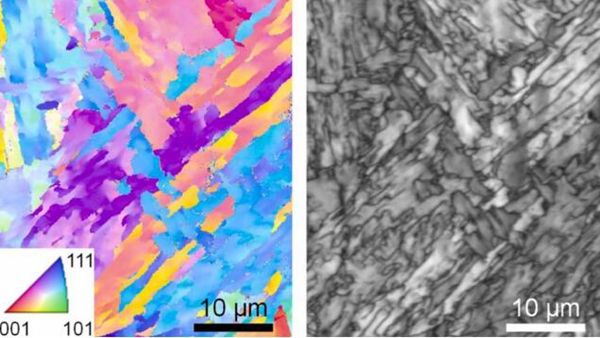17-4 PH stainless steel is a precipitation-hardening martensitic stainless steel typically used in applications requiring high strength and moderate corrosion resistance. A material with high tensile strength, this grade is twice as strong as the most commonly used stainless steels, 304 and 316. A group of researchers from the National Institute of Standards and Technology (NIST), the University of Wisconsin-Madison and Argonne National Laboratory have identified specific 17-4 steel compositions, and the new findings could help manufacturers of 17-4 PH parts reduce costs and increase manufacturing flexibility through3D printing.

Microscopic image of stainless 3D printed 17-4 stainless steel, micrograph showing elongated grains inside the 3D printed stainless steel
The colors on the left side of the image represent the different orientations of the crystals in the alloy. © University of Wisconsin-Madison
Fractionation ratios change print results
3D printing metals is particularly complex, in part because the temperature changes so quickly during the process. Despite the advantages over traditional manufacturing, 3D printing with certain composition ratios can produce overly inconsistent results.
Additive manufacturing of PBF metals essentially involves "welding" millions of tiny metal powder particles into a single unit using a high-power source such as a laser, by melting the metal powders into a liquid and then cooling them into a solid, according to NIST scientist Zhang Fan, the cooling rate of metal 3D printing is high, sometimes higher than a million degrees per second. degrees Celsius, and this extreme non-equilibrium condition poses an extraordinary set of measurement challenges.
Because the material heats and cools so rapidly, the arrangement or crystal structure of the atoms within the material changes rapidly and is difficult to determine, according to NIST scientist Zhang Fan. Without knowing what happens to the crystal structure of 3D printed steel, researchers have been trying to 3D print 17-4 PH stainless steel for years, and the crystal structure of the print results must be just right - a material called martensite - to demonstrate its highly sought-after material properties.

© 3D Science Valley White Paper
XRD Insight into the Printing Process
So, what happens during rapid temperature changes?
To find a way to get results from martensitic 3D printing, researchers used synchrotron X-ray diffraction, or XRD, to look at the rapid structural changes that occur within milliseconds.
Observing rapid structural changes that occur in milliseconds through X-ray diffraction (XRD) is a fundamental technique in materials science and engineering, providing information about well-defined structures, such as lattices or interfaces in multilayer materials.
According to Professor Chen of Mechanical Engineering at the University of Wisconsin-Madison, the X-rays interact with the material during the XRD process, creating a signal that is like obtaining a fingerprint corresponding to the specific crystal structure of the material.
The team mapped how the crystal structure changes during the 3D printing process, revealing how certain factors they control, such as the composition of the powdered metal, affect the entire process.
While iron is the main component of 17-4 PH steel, the composition of the alloy can contain varying amounts of up to a dozen different chemical elements. Using clear images of the structural dynamics of the 3D printing process as a guide, the researchers were now able to fine-tune the composition of the steel to find a set of components that included only iron, nickel, copper, niobium and chromium.
Composition control is indeed key to 3D printing alloys, and by controlling the composition, one is able to control how the 3D printing process cures. The researchers also showed that composition consistently produces fully martensitic 17-4 PH steels over a wide range of cooling rates, such as between 1,000 and 10 million degrees Celsius per second.
This new research could also cause a stir in the 17-4 PH steel field, and the XRD-based approach could also be used to optimize other alloys for more predictable 3D printing, especially since the information revealed by XRD could be used to build and test computer models designed to predict the quality of 3D printed parts.



